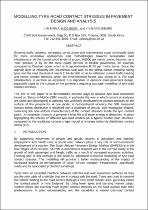JavaScript is disabled for your browser. Some features of this site may not work without it.
- ResearchSpace
- →
- Research Publications/Outputs
- →
- Conference Publications
- →
- View Item
| dc.contributor.author |
Maina, JW

|
|
| dc.contributor.author |
De Beer, Morris

|
|
| dc.contributor.author |
Van Rensburg, Yvette

|
|
| dc.date.accessioned | 2013-11-06T09:14:59Z | |
| dc.date.available | 2013-11-06T09:14:59Z | |
| dc.date.issued | 2013-07 | |
| dc.identifier.citation | Maina, J.W., De Beer, M. and Van Rensburg, Y. 2013. Modelling tyre-road contact stresses in pavement design and analysis. In: The 32nd Southern African Transport Conference, CSIR International Convention Centre, Pretoria, South Africa, 8-11 July 2013 | en_US |
| dc.identifier.uri | http://hdl.handle.net/10204/7032 | |
| dc.description | The 32nd Southern African Transport Conference, CSIR International Convention Centre, Pretoria, South Africa, 8-11 July 2013. Published by SATC. | en_US |
| dc.description.abstract | Growing traffic volumes, increasing construction and maintenance costs continually drive for more innovative approaches and methodologies towards sustainable road infrastructure. At the current price levels of around R6000 per metric tonne, bitumen, as a “raw” product, is by far the most costly element in flexible pavements, for example compared to Crushed stone, which is at approximately R170 per metric tonne. Since the asphalt layer or relatively thin bituminous seal acts as the stress barrier between rolling tyres and the road structure it needs to be durable so as to withstand current traffic loading and hence contact stresses, given the environmental forces also acting on it. For road infrastructure to perform as expected, it is important to optimize road pavement design, especially close to the surface of the pavement requiring accurate modelling of tyre-road contact stresses. The aim of this paper is to demonstrate modern ways to idealise tyre-road interaction based on Stress-In-Motion (SIM) results, in particular the way in which numerical analyses are used (and developed) to address non-uniformly distributed tyre contact stresses on the surface of the pavements. A tyre model is demonstrated whereby the SIM measured contact stress distribution is idealised with a multitude of circular and rectangular shapes, mimicking the non-uniform characteristics of the contact stresses inside the tyre contact patch. An example, in terms of pavement layer life and strain energy of distortion, is given highlighting the effects of different tyre-road models on a typical flexible road structure, compared to the traditional circular shape model of a single uniformly distributed contact stress. | en_US |
| dc.language.iso | en | en_US |
| dc.publisher | SATC 2013 | en_US |
| dc.relation.ispartofseries | Workflow;11721 | |
| dc.subject | Sustainable road infrastructure | en_US |
| dc.subject | Road construction | en_US |
| dc.subject | Pavement design | en_US |
| dc.subject | Stress-in-Motion | en_US |
| dc.subject | SIM | en_US |
| dc.subject | Road structures | en_US |
| dc.title | Modelling tyre-road contact stresses in pavement design and analysis | en_US |
| dc.type | Conference Presentation | en_US |
| dc.identifier.apacitation | Maina, J., De Beer, M., & Van Rensburg, Y. (2013). Modelling tyre-road contact stresses in pavement design and analysis. SATC 2013. http://hdl.handle.net/10204/7032 | en_ZA |
| dc.identifier.chicagocitation | Maina, JW, Morris De Beer, and Yvette Van Rensburg. "Modelling tyre-road contact stresses in pavement design and analysis." (2013): http://hdl.handle.net/10204/7032 | en_ZA |
| dc.identifier.vancouvercitation | Maina J, De Beer M, Van Rensburg Y, Modelling tyre-road contact stresses in pavement design and analysis; SATC 2013; 2013. http://hdl.handle.net/10204/7032 . | en_ZA |
| dc.identifier.ris | TY - Conference Presentation AU - Maina, JW AU - De Beer, Morris AU - Van Rensburg, Yvette AB - Growing traffic volumes, increasing construction and maintenance costs continually drive for more innovative approaches and methodologies towards sustainable road infrastructure. At the current price levels of around R6000 per metric tonne, bitumen, as a “raw” product, is by far the most costly element in flexible pavements, for example compared to Crushed stone, which is at approximately R170 per metric tonne. Since the asphalt layer or relatively thin bituminous seal acts as the stress barrier between rolling tyres and the road structure it needs to be durable so as to withstand current traffic loading and hence contact stresses, given the environmental forces also acting on it. For road infrastructure to perform as expected, it is important to optimize road pavement design, especially close to the surface of the pavement requiring accurate modelling of tyre-road contact stresses. The aim of this paper is to demonstrate modern ways to idealise tyre-road interaction based on Stress-In-Motion (SIM) results, in particular the way in which numerical analyses are used (and developed) to address non-uniformly distributed tyre contact stresses on the surface of the pavements. A tyre model is demonstrated whereby the SIM measured contact stress distribution is idealised with a multitude of circular and rectangular shapes, mimicking the non-uniform characteristics of the contact stresses inside the tyre contact patch. An example, in terms of pavement layer life and strain energy of distortion, is given highlighting the effects of different tyre-road models on a typical flexible road structure, compared to the traditional circular shape model of a single uniformly distributed contact stress. DA - 2013-07 DB - ResearchSpace DP - CSIR KW - Sustainable road infrastructure KW - Road construction KW - Pavement design KW - Stress-in-Motion KW - SIM KW - Road structures LK - https://researchspace.csir.co.za PY - 2013 T1 - Modelling tyre-road contact stresses in pavement design and analysis TI - Modelling tyre-road contact stresses in pavement design and analysis UR - http://hdl.handle.net/10204/7032 ER - | en_ZA |






